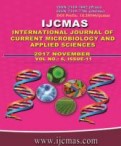


 National Academy of Agricultural Sciences (NAAS)
National Academy of Agricultural Sciences (NAAS)

|
PRINT ISSN : 2319-7692
Online ISSN : 2319-7706 Issues : 12 per year Publisher : Excellent Publishers Email : editorijcmas@gmail.com / submit@ijcmas.com Editor-in-chief: Dr.M.Prakash Index Copernicus ICV 2018: 95.39 NAAS RATING 2020: 5.38 |
Field observation at weekly intervals on the occurrence of mango hopper population under Ultra high density planting system of mango was carried out at R & D farm, Jain Irrigation Systems Limited, Udumalpet, Tamil Nadu during 2014. The incidence of hopper population was noted from 4th week of January which reaches its peak (80 hoppers/20 panicles) during fourth week of February corresponding with 8th standard week. The hopper population declined from second week of March which disappeared during second week of May. Reoccurrence of hopper population was observed in first week of September with peak population of 4.8 hoppers /20 panicles in vegetative phase after pruning. Thus two distinct peaks were observed during crop period, one in reproductive and another in vegetative phase. Maximum temperature, morning RH, evaporation and sunshine hours influenced the hopper infestation positively but not significant whereas minimum temperature, afternoon RH, rainfall and wind speed showed non-significant negative correlation. The regression analysis also indicated the influence of crop phenology with hopper incidence as compared to abiotic factors prevailed during 2014 at R &D farm, JISL, Udumalpet, TN.
 |
 |
 |
 |
 |